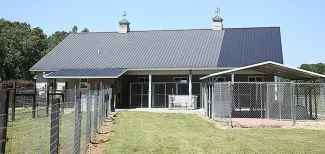Many considerations go into building a kennel or adding on to an existing kennel. At Kennels in the Country in Sugar Valley, Georgia, Justin Smithey, who owns the handling/breeding and boarding kennel with his wife, Cheslie Pickett, says, “Our chief concern was providing a safe, comfortable, healthy living space for the dogs. We wanted our kennel to be attractive to owners and appealing to dogs.” Here are tips from Kennels in the Country to consider as you plan your kennel.
Location is Everything
First check the city, county and state zoning requirements. Our kennel had to be 1,000 feet away from a residence, thus we built it in the center of our 28 acres. Your kennel should be located away from neighbors so barking dogs are not a problem. You also should have good drainage and room for future expansion.
Creatures of Comfort
Make sure the kennel is built so the hot afternoon sun does not face kennel runs. Our dog runs face the east and northeast, giving them the early morning sun. The office, grooming room, laundry, and kitchen are located at the front of the building where the afternoon sun hits.
Fresh Air is Invigorating
Air quality is important. We installed a large exhaust fan that pulls air through the kennel when we open a couple of windows on the opposite side of the kennel. In the warm summer months, we keep the exhaust fan going regularly. In winter, we run it for about an hour every day. This is one of our favorite features.
Concrete Works Well
We chose a concrete foundation for our kennel for multiple reasons. The concrete on the outside runs allows for easy pickup of solid waste, and then we hose urine and water waste into drains that feed into a septic system. A sealed finish protects the concrete from urine and water seeping in. The inside runs have epoxy paint on the walls and floors that allows for surfaces to be thoroughly disinfected against disease and parasites, and we added texture to the concrete flooring to provide traction. The higher initial cost of concrete is offset by its lower maintenance cost, ease of cleaning and attractive, clean appearance.
Designed for Exercise
It was important to us to have safe, spacious exercise paddocks that would allow the Whippets and Italian Greyhounds that we breed and show, as well as dogs that are boarding, to run free. All our kennel runs feed into exercise paddocks that are separated by 5-foot-tall woven horse fencing with 2-by-4 inch mesh weaving secured on wooden posts. Custom chain link gates separate the exercise paddocks, and we added pavers under the gates and along the fence lines for security.
Professional handlers Justin Smithey and Cheslie Pickett, pictured with Whippets “Lexie” (GCH Bo-Bett Lanexa Legionnaire), left, and “Angel” (GCH Bo-Bett Appraxin Angel), visited many boarding and show kennels before building their own in Sugar Valley, Georgia.
The outside runs of Kennels in the Country, above, have a roof overhang for protection from inclement weather, and the runs open to grass paddocks that provide a safe, secure area for exercise. The kennel façade, right, was built facing west so the office, rather than the kennels, would receive the sun in the warmest part of the day.
Kennels with glass doors, above, complement chain link runs opposite them. A large exhaust fan on the far wall helps to keep the air fresh when open windows on the opposite side of the building pull the air through. A separate area, right, allows for whelping and raising personal show dogs, and built-in crates provide a comfortable space for the Italian Greyhounds and Whippets.

